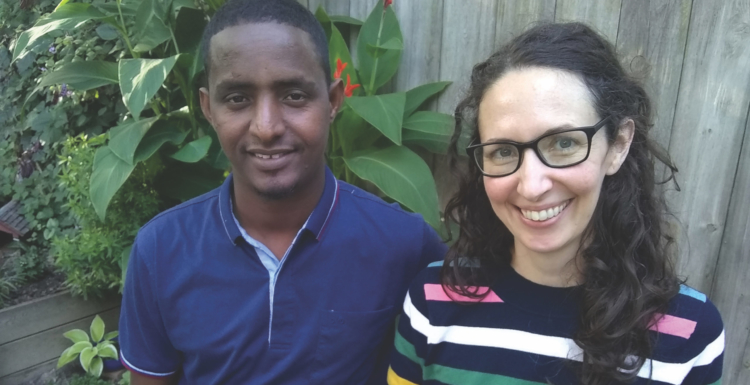
When Stars Are Scattered: National Book Awards finalists Jamieson and Mohamed
. . .
Friday, February 26th, 2021
Visual art, combined with literature, is an immensely powerful way to tell a story.
That artistic collaboration is what brought together Newbery Honor-winning graphic novelist Victoria Jamieson and Omar Mohamed, who grew up in the Dadaab refugee camp in Kenya. Their resulting graphic novel, When Stars Are Scattered, tells the childhood story of Mohamed and his brother, Hassan. Last year the novel was named a National Book Awards Finalist for Young People’s Literature.
On March 2, Jamieson and Mohamed join PCA&D online for a presentation about their artistic collaboration.
Until recently, Mohamed lived in Lancaster and worked for CWS Lancaster as a resettlement case manager and cultural navigator for new refugees. He is the founder of Refugee Strong, a nonprofit organization committed to empowering children living in refugee camps by providing support and hope through education. He will join the PCA&D event from Kenya, where he is working with that organization.
Virtual Talk: Victoria Jamieson and Omar Mohamed, When Stars Are ScatteredTuesday, March 21-2 pm
Jamieson, a native of Havertown and graduate of Rhode Island School of Design, lives with her family in Pennsylvania. She shared with PCA&D what the artistic collaboration with Mohamed looked like:
According to this article, you met Omar through the organization where he formerly worked, Church World Service? That almost feels like, as a creative, being open to inspiration even when you are “not working” on your art — that it is important to always keep your mind open for possibility and insight?
VJ: Yes, I would say that’s true. I definitely had my mind open at that point. I had been volunteering with a refugee resettlement agency in Portland, Oregon, before moving to Pennsylvania. Hearing stories from people I met through that experience engaged my curiosity and made me want to learn more.
Was Omar your only resource for the book, or did you turn to other sources to depict the camp, the landscape, to get the feel of the novel correct?
VJ: I did research on my own. Omar recommended some documentaries on Dadaab, and I read whatever books and articles I could on life in Dadaab. There weren’t many resources that dealt particularly with the daily life of children in the camp, which is what I was interested in. For those daily life stories, Omar was the main resource. We also shared the book with friends he grew up with in the camps, as well as other former refugees and social workers to makes sure the book was as accurate as possible.
What was that back-and-forth with Omar like? What kind of layer of meaning does it add, to be collaborating with someone like this? And how did that affect the way you typically work?
VS: We started the story by working very closely together. I would meet Omar on his lunch break or after work, and he would tell me stories of his life and I would write them down. From then on it was very collaborative; as I would write pages or start doing sketches, we would send them back and forth with any corrections or changes to be made. I have never collaborated with someone like this on a project; it is a project that I could not have done on my own. I usually invent stories on my own, in my own head; this experience taught me the importance of listening to the stories of others.
The March 2 online visit by Victoria Jamieson and Omar Mohamed is free and open to the public. Members of the public interested in attending may email Jennifer Kopf at jkopf@pcad.edu to register for the link.
Top photo: Omar Mohamed, left, and Victoria Jamieson, who collaborated on the graphic novel “When Stars Are Scattered.”
